Looking for a centerfire rifle cartridge that delivers incredible accuracy and heavy hitting performance at long range to hunt with this fall? Here’s what you need to know about the 7mm PRC.
Hornady made a gigantic splash when they announced the brand new 7mm Precision Rifle Cartridge (7mm PRC) in late 2022. In fact, I don’t think I’ve ever seen as much excitement surrounding a new cartridge as was the case with the 7mm PRC.
While many hunters and shooters were overjoyed with the introduction of the new cartridge, others were skeptical about the need for yet another new round. This was especially true considering the ongoing ammunition shortage at the time.
I’ll admit that I was initially unconvinced about the touted benefits of the 7mm PRC. However, I was pleasantly surprised by what I learned when I looked at the new 7mm PRC in detail.
In this article, I’m going to discuss the history as well as the strengths and weaknesses of the 7mm PRC in detail. I’ll also provide some information on how the 7mm PRC compares to the other cartridges in Hornady’s Precision Rifle Cartridge family with the 6.5 PRC and the 300 PRC to give you an idea of what sort of performance you can expect from the cartridge and so you can decide if it best fits your needs as a hunter.
Table of Contents
Before we get started, I have an administrative note:
Some of the links below are affiliate links. This means I will earn a small commission (at no extra cost to you) if you make a purchase. This helps support the blog and allows me to continue to create free content that’s useful to hunters like yourself. Thanks for your support.
Additionally, I recorded an entire podcast episode on this exact subject. If you’d rather listen than read, click the appropriate link below to listen to this episode on your preferred podcasting service.
7mm PRC Podcast
Apple | Google | iHeart | Spotify | Pandora
7mm PRC Profile
First, I recorded an entire video on this exact subject. If you’d rather listen or watch than read, watch the YouTube video below.
The blue wildebeest bull almost looked bored as he turned his head to look at me. After staring me down for a few seconds, he flicked his tail, slowly turned his head away from me, and reached down to take another mouthful of food.
This was a very nice bull and he was only about 80 yards away, but daylight was fading fast and I did not have much time remaining to make a shot. Fortunately, the bull was as calm as could be. Perhaps he felt secure in the growing darkness.
Knowing it was now or never, I waited for him to turn his head again, took aim, exhaled, and squeezed the trigger. My Christensen Arms Ridgeline FFT chambered in 7mm PRC barked and sent a 160 grain CX bullet straight into that wildebeest.
He dropped instantly at the shot and never even twitched afterwards.

I’m sure that wasn’t the first blue wildebeest taken with the new 7mm Precision Rifle Cartridge or that new 160gr CX bullet, but there were probably only a handful of other hunters who had done so at that point.
Even so, I was quite impressed with the performance of that cartridge and so were the other hunters and Professional Hunters in camp with me at the time.
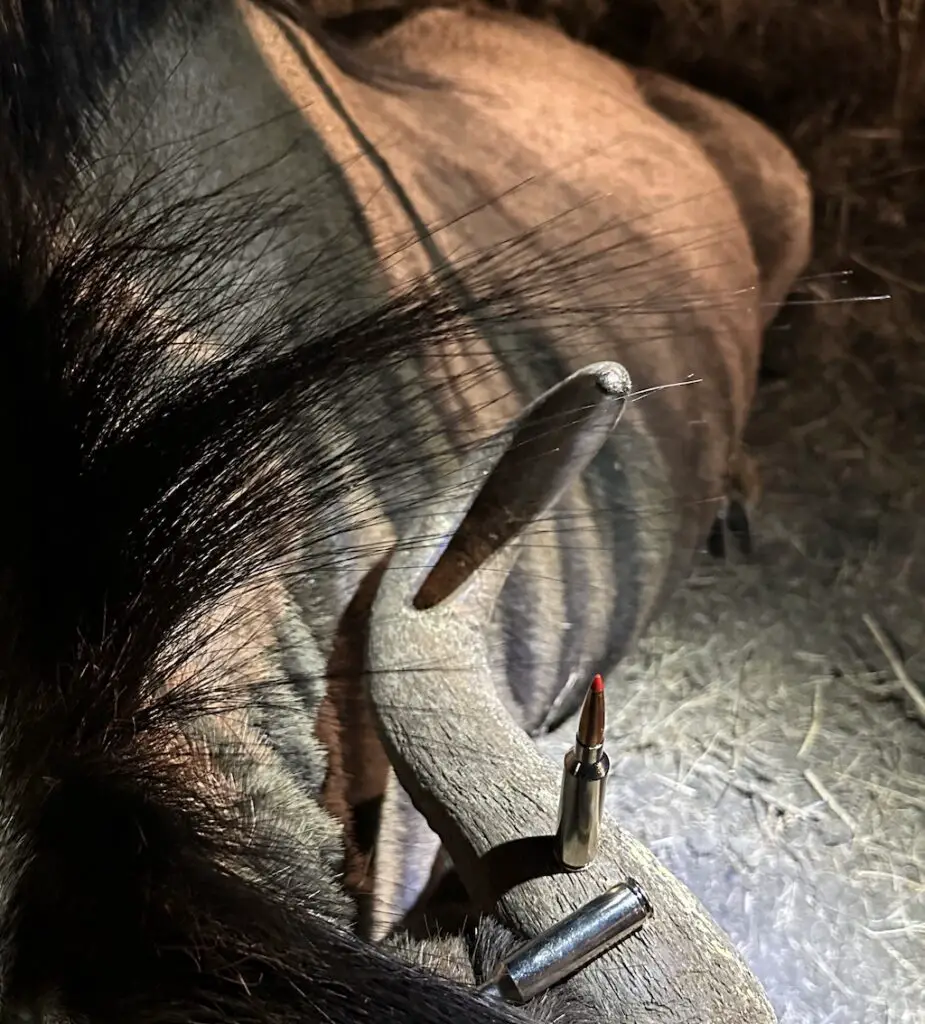
Now that’s all well and good, but there are plenty of other cartridges capable of cleanly bringing down a blue wildebeest. What’s all the hubbub about with the 7 mm Precision Rifle Cartridge? Is this thing the real deal? Or will it be just another flash in the pan that’s all hype for a couple of years before disappearing?
Well, let’s rewind a couple of years and go back to the introduction of the Precision Rifle Cartridge family.
Extra long range shooting and Precision Rifle Series competitions (PRS) had become really popular during the first and second decades of the 21st Century. With that in mind, rifle and ammunition manufacturers looked for different ways to serve those markets.
While they were initially developed independently to satisfy very different needs, Hornady released the 6.5 PRC and the 300 PRC around the same time a few years ago. The two cartridges were somewhat closely related though and also incorporated many of the same design features: a long head height, a long case neck, a relatively fast rifling twist rate, and some specific chamber design features to enhance accuracy.
Additionally, those cartridges use modified .375 Ruger cartridge cases. The .375 Ruger was designed with the same .532″ case head diameter as the .375 H&H. However, unlike the .375 H&H (and cartridges like the 7mm Remington Magnum and .300 Winchester Magnum descended from it) the .375 Ruger is a beltless cartridge with minimal taper, so the actual body of the .375 Ruger case is larger in diameter than the .375 H&H.
This results in a slight increase in case capacity for the 375 Ruger (and all cartridges descended from it) while still working with a standard magnum bolt face.
Head height is the amount of space available for the bullet outside the case while staying within SAAMI specifications for the cartridge. Put simply, more head height facilitates the use of very long, aerodynamic bullets without requiring them to be seated so deeply into the case that they intrude into the powder column.
In that same vein, rifles chambered in Precision Rifle Cartridges typically have a relatively fast rifling twist rate (usually 1:8″) in order to stabilize those long, heavy, high BC bullets. They’re also built with a long enough case neck to provide adequate neck tension with those long bullets, which can help with accuracy.
They also have a relatively “tight” throat diameter.
The throat is the smooth portion of a rifle barrel closest to the cartridge. Having a more snug throat diameter means there’s less room for the bullet to yaw upon firing before engaging the rifling. This can also help enhance accuracy.
Well, the 6.5 PRC, 7mm PRC, and 300 PRC have throat diameters just .0005″, .0006″, and .0008″ larger than the bullet diameter respectively. Compare that to .002″ .0026″, and .007″ of clearance around bullets in the .308, 30-06, and 300 Win Mag.
The end result was both the 6.5 PRC and 300 PRC were optimized to accurately shoot very long, sleek, high BC bullets at magnum velocities and deliver outstanding accuracy in the process.
Well, the success of the 6.5 PRC and 300 PRC had many in the shooting community clambering for a 7mm PRC to fill the gap between the little 6.5 and the much larger 300 PRC.
They got what they asked for when Hornady received formal SAAMI certification for the 7mm PRC in 2022 and then officially announced the new cartridge to the world later that year.
That cartridge incorporates all of those same design features I just mentioned with the 6.5 PRC and 300 PRC and neatly fills the gap in performance between its smaller and larger brothers.
Long story short, the 7mm PRC is an efficient cartridge designed specifically to launch the heaviest and most aerodynamic 7mm bullets while at the same time providing a high degree of accuracy potential from off the shelf rifles using factory ammunition.
7mm PRC Ballistics
Typical 7mm PRC ballistics are a 175-grain bullet at 3,000fps (3,496 ft-lbs) or a 180-grain bullet at 2,950fps (3,477 ft-lbs). Both loads use long, aerodynamic, heavy for caliber bullets that minimize bullet drop and wind drift at extended range.
When compared to other popular 7 mm magnum cartridges, 7mm PRC factory loads generally have slightly faster muzzle velocity than the 7 mm Rem Mag, even when using heavier bullets with a higher BC while also having longer barrel life than fire breathing magnums like the 28 Nosler.
Additionally, it’s also worth noting that the 7mm PRC is optimized for use with a 24″ barrel instead of the 26″ barrels that are common with some other magnum cartridges. The cartridge also has a SAAMI spec rifling twist of 1:8″ in order to stabilize those high BC bullets.
With careful handloading, it’s possible achieve slightly higher velocities with the cartridge and/or utilize even heavier and more aerodynamic bullets that deliver even better long-range performance at the range.
Specifically, maximum handloads published by Hornady show a velocity of 2,900fps with a 190 grain A-Tip Match bullet (which has a ridiculously high G1 BC of .838).
6.5 PRC vs 7mm PRC vs 300 PRC
It’s only natural to wonder how the 7mm PRC stacks up next to its siblings in the Precision Rifle Cartridge family.
First, the 6.5 PRC (left in the photo below) is designed to fit in a short action rifle, the 7mm PRC is designed to fit in a standard long action rifle (same as a 30-06), and the 300 PRC (right in the photo below) is designed to fit in a magnum length rifle.
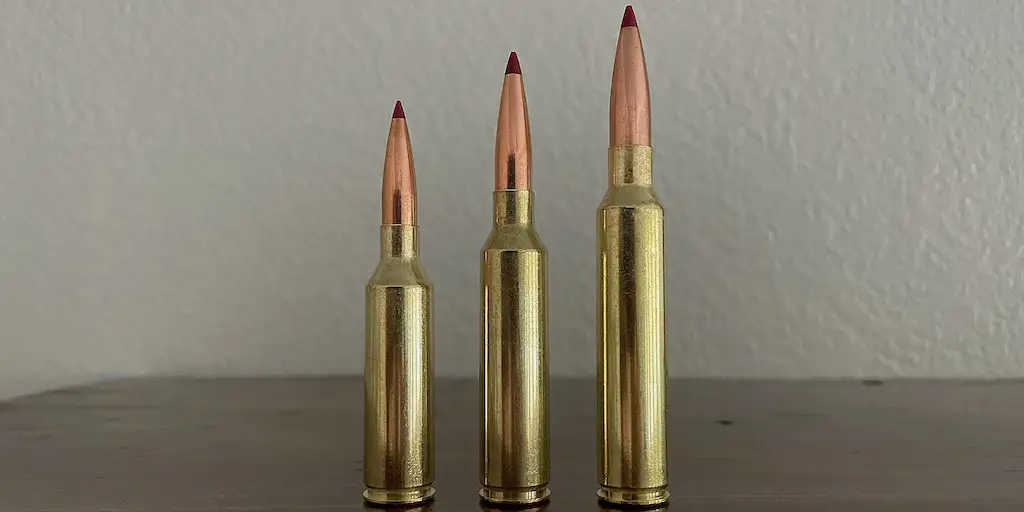
Next, all three cartridges use different bore sizes: the 6.5 PRC uses .264″ bullets, the 7mm PRC uses .284″ bullets, and the .300 PRC uses .308″ bullets.
Additionally, they all use different weight bullets.
While the 6.5 PRC can use lighter 120gr, 127gr, and 130gr bullets, it’s most commonly used with 140gr, 143gr, or 147gr bullets.
The 7mm PRC most often uses bullets in the 150-180 grain range, with 160 grain bullets, 175 grain bullets, and 180 grain bullets being most common.
Finally, though the 300 PRC can certainly use lighter .30 caliber bullets, it’s most commonly available with either 190gr, 212gr, or 225gr bullets in factory loadings. Handloaders have also utilized bullets weighing up to 250gr with the cartridge with success.
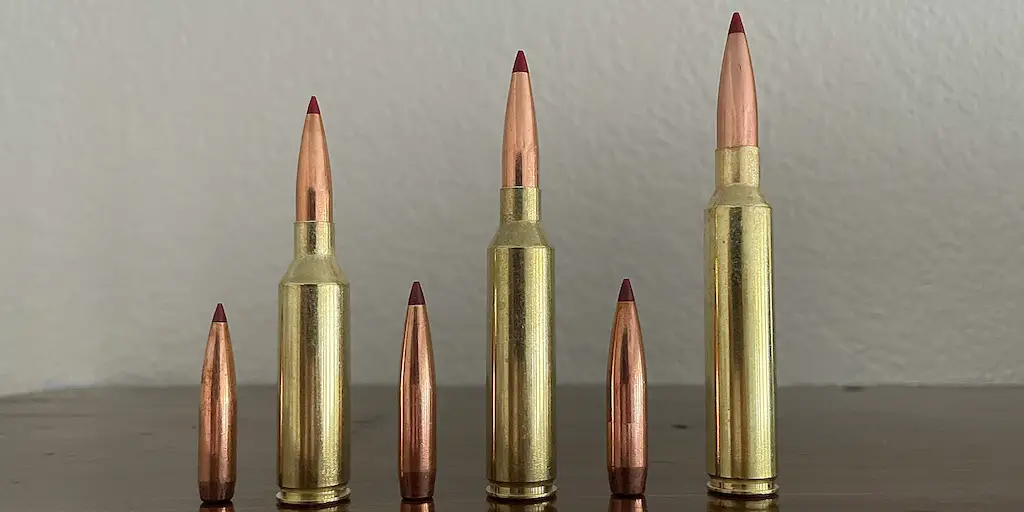
Since it’s designed for use in magnum length rifle actions, the 300 PRC has the longest maximum overall length (3.7″) and longest case length (2.58″). The 7mm PRC has a maximum overall length of 3.34″ and a case length of 2.28″. The 6.5 PRC, which is the smallest of the bunch, has maximum overall and case lengths of 2.955″ and 2.03″ respectively.
Since they’re all descended from the 375 Ruger, all three cartridges have the same .532″ rim diameter and beltless case though. The same is true with the 30 degree shoulder they all share.
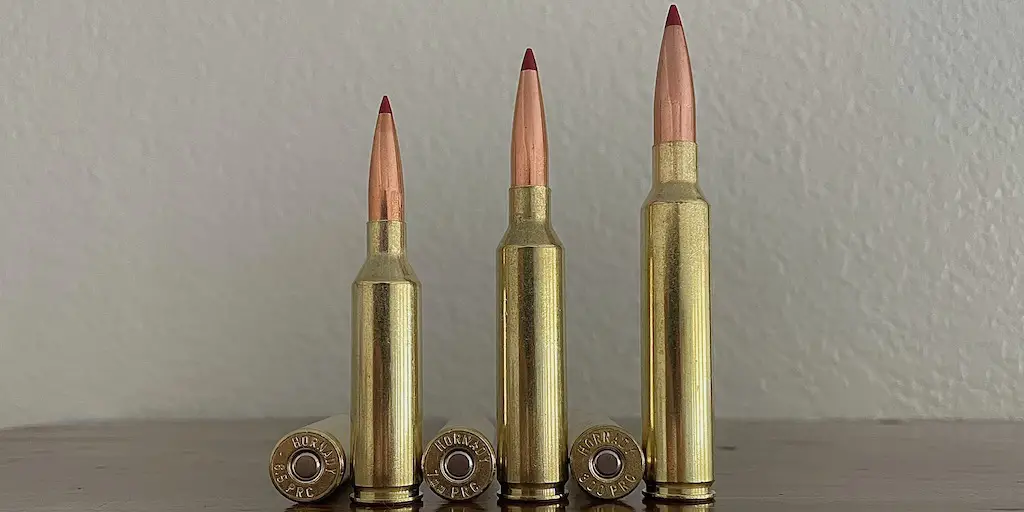
With all that in mind, the 300 PRC has the largest case capacity, followed by the 7mm PRC and then the 6.5 PRC. All case capacities obtained from BackFire.TV.
Finally, the 6.5 PRC, 7mm PRC, and 300 PRC all have the same SAAMI maximum pressure of 65,000psi.
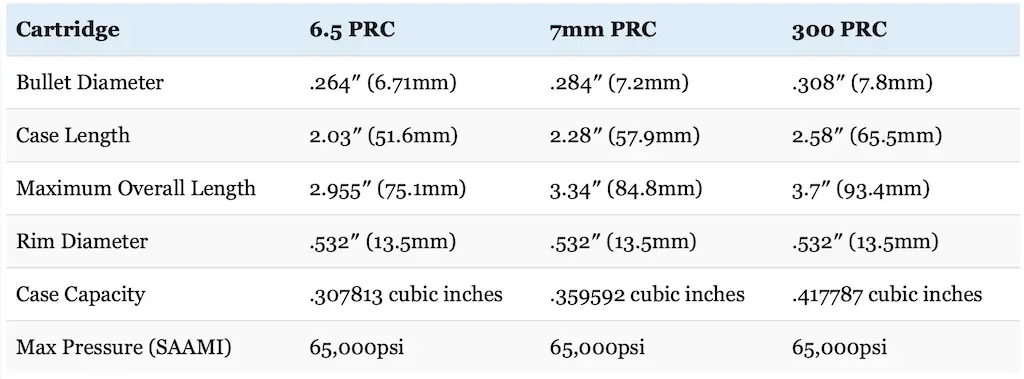
Those differences in the external dimensions of the 6.5 PRC, 7mm PRC, and 300 PRC translate into some interesting differences in their ballistic performance.
The table below compares Hornady Outfitter and Precision Hunter factory ammo in 6.5 PRC loaded with 130gr CX (.489 BC) and 143gr ELD-X (.625 BC) bullets, in 7mm PRC loaded with 160gr CX (.596 BC) and 175gr ELD-X (.689 BC), and in 300 PRC loaded with 190gr CX (.575 BC) and 212gr ELD-X (.663 BC) bullets.
Note: the CX is a lead free monolithic projectile designed by Hornady to deliver high weight retention and deep penetration. However, as a monolithic projectile, those bullets do not have nearly as high of a BC as the ELD-X projectiles.
Additionally, while the ELD-X is designed to expand at velocities as low as 1,600fps, the CX requires a much faster impact velocity of at least 2,000fps.
All six loads used a 200 yard zero.
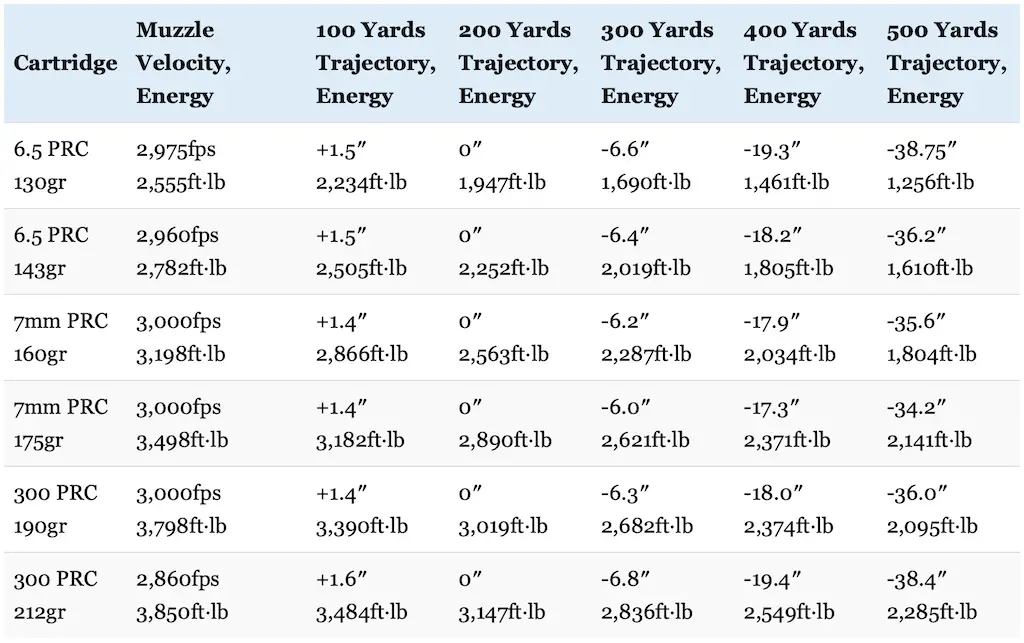
As you can see, the 7mm PRC ELD-X and 160gr CX loads are actually the two flattest shooting loads of the bunch! That really says something when a monometal bullet like the 160-grain CX is shooting flatter than lead core projectiles in other high performance cartridges.
This is due to the fact that the 7mm PRC has a higher muzzle velocity than either the 6.5 PRC or the 300 PRC combined with the fact that the 7mm PRC bullets are so aerodynamic. That 175gr ELD-X has the highest BC of anything in this comparison and, while the 160gr CX has a lower BC than any of the ELD-X bullets here, the still relatively high BC of that bullet combined with its high muzzle velocity gives it a very flat trajectory.
However, all these loadings are relatively flat shooting and just 4.5″ separates the flattest shooting load from the most arching load at 500 yards.
Not surprisingly, the 300 PRC has more muzzle energy across the board than the 7mm PRC and the 6.5 PRC. Even so, the 7mm PRC still does pretty well here and both loads for that cartridge carry over 1,800 ft-lbs of kinetic energy out past 500 yards (over 2,100ft-lbs in the case of the 175gr ELD-X).
When compared to the 6.5 PRC, the various 7mm PRC loads have about 15-37% more muzzle energy and 12-70% more retained energy at 500 yards.
Interestingly, the 160gr CX 7mm PRC load actually has a very similar trajectory to the 143gr ELD-X 6.5 PRC load. The ELD-X has a little bit higher BC than the CX bullet here, but the 160gr CX starts out going a little faster and they track very closely with the 6.5 PRC load having just .6″ more bullet drop at 500 yards.
On the other hand, the various 300 PRC loads have about 9-20% more muzzle energy than the 7mm PRC. The 212 ELD-X loading for the 300 PRC has about 7-27% more energy than the 7mm PRC loadings at 500 yards. However, the 175gr ELD-X loading for the 7mm PRC actually “catches” the 190gr CX loading for the 300 PRC around 400 yards in terms of kinetic energy and actually has about 2% more kinetic energy at 500 yards since it uses a more aerodynamic bullet.
At the same time, the 300 PRC has about 36-50% more muzzle energy and 30-82% more retained energy than the 6.5 PRC at 500 yards.
Additionally, all the loads in this comparison easily maintain at least 1,000 ft-lbs of energy out past 500 yards. Everything but the 6.5 PRC 130gr CX load has at least 1,500 ft-lbs of energy at that range and the 7mm PRC 175gr ELD-X and both 300 PRC loads maintain over 2,000ft-lbs of energy past 500 yards.
So, the big takeaways so far are that the 7mm PRC is the flattest shooting cartridge of the bunch, but the 300 PRC is generally a harder hitting cartridge.
Those trends continue as we look out to even longer ranges. Note that I’m not advocating using any of these cartridges for hunting at extreme range, but the differences between these cartridges become even more stark as ranges increase.
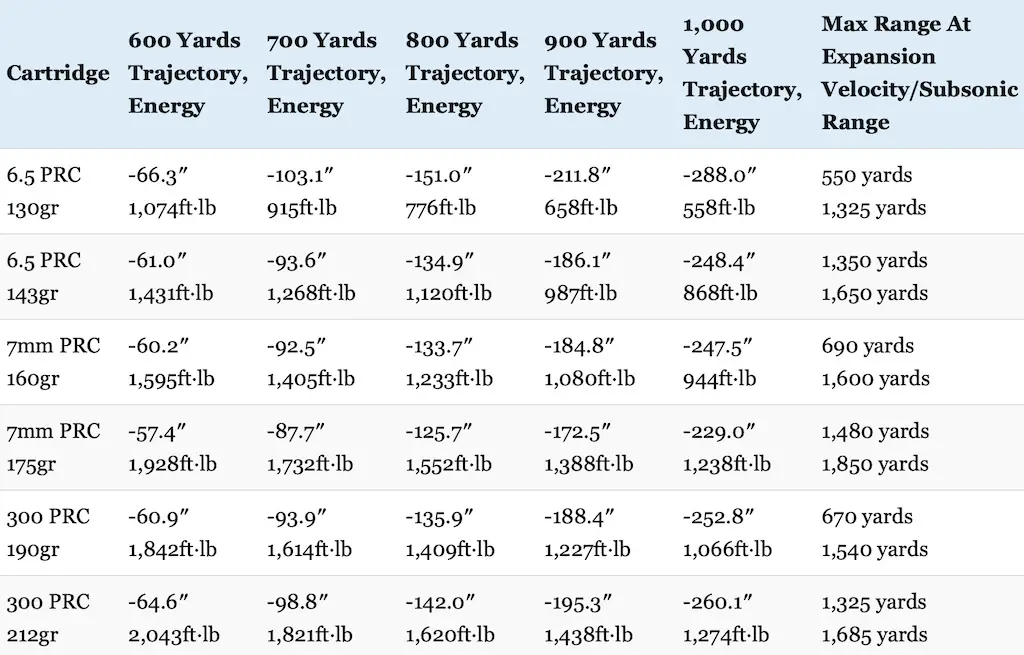
Once again, the 7mm PRC has the flattest trajectory of the bunch and still outperforms the 6.5 PRC in the kinetic energy department.
Interestingly, the 175gr ELD-X loading for the 7mm PRC has nearly the same amount of kinetic energy remaining at 1,000 yards as the 212gr ELD-X loading for the 300 PRC. Once again, this is because that 175gr ELD-X has the highest BC of all bullets used in this comparison which allows it to retain energy and velocity better than everything else.
For that reason, that particular 7mm PRC loading also travels the farthest before dipping below its minimum recommended impact velocity of 1,350fps as well as before finally going subsonic out at a staggering 1,850 yards.
Now let’s talk about another important factor: wind.
The chart below compares how much a 10 mile per hour crosswind impacts those same 6.5 PRC, 7mm PRC, and 300 PRC loads out to 500 yards.
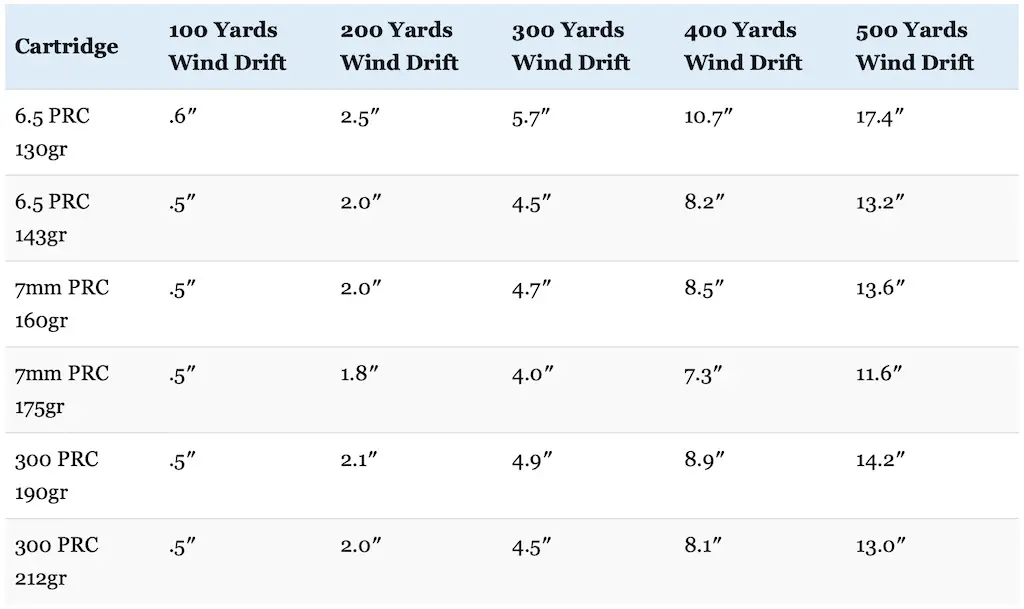
The same general trends hold true with regards to wind deflection as well.
The 7mm PRC ELD-X has the least wind deflection, followed by the 300 PRC ELD-X load, the 6.5 PRC ELD-X load, the 7mm PRC CX load, the 300 PRC CX load, and finally the 6.5 PRC CX.
While all of these loads (but to a lesser extent with the 130gr CX) are pretty darn good with the wind, that 175gr ELD-X load for the 7mm PRC is really starting to stand apart from the others here.
Indeed, that 1.4″ of difference in wind deflection between the 175gr ELD-X and the 212gr ELD-X might not sound like a tremendous amount, but that’s still a 12% advantage in favor of the 7mm PRC.
Once again, those differences become even more apparent at longer range.
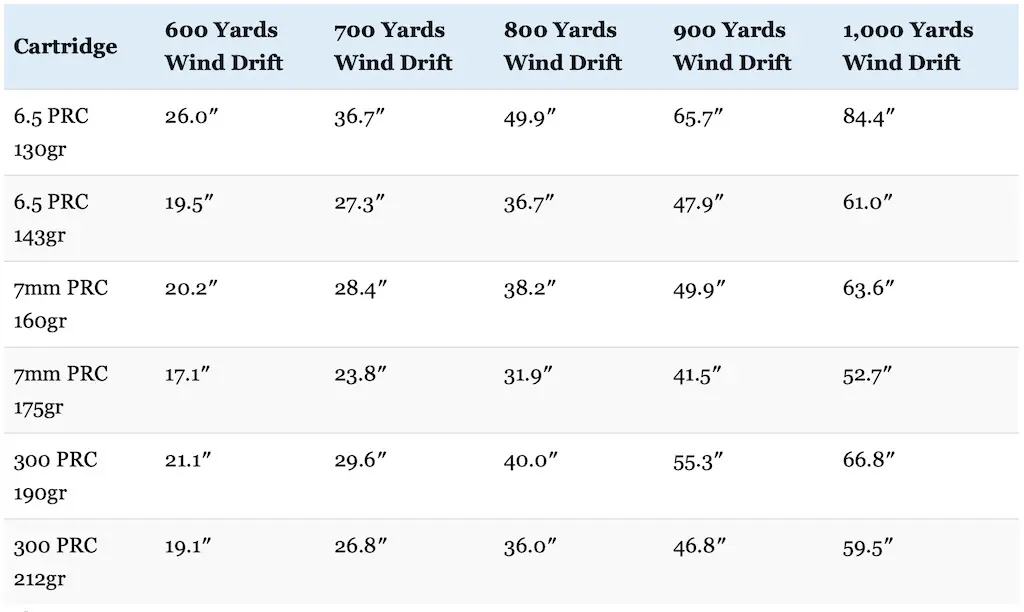
For instance, that 175gr ELD-X has about 7″ less wind deflection than the 212gr ELD-X and about 8″ less wind deflection than the 143gr ELD-X at 1,000 yards.
This is an area where all three PRC cartridges really shine with their very high BC bullets and all of them perform a lot better than most comparable loadings at extended range. However, a hunter or shooter looking for that little bit of an advantage would be well served to look at the 175gr ELD-X loading for the 7mm PRC here.
Note that while the CX loadings seem to hold their own in terms of energy and trajectory, the ELD-X loadings for each cartridge start to leave them in the dust with wind deflection due to their much higher BC.
Now let’s talk about recoil.
The table below compares the recoil produced by handloads that are very similar to the Hornady Precision Hunter loads compared above for the 6.5 PRC, 7mm PRC, and 300 PRC when fired from identical rifles.
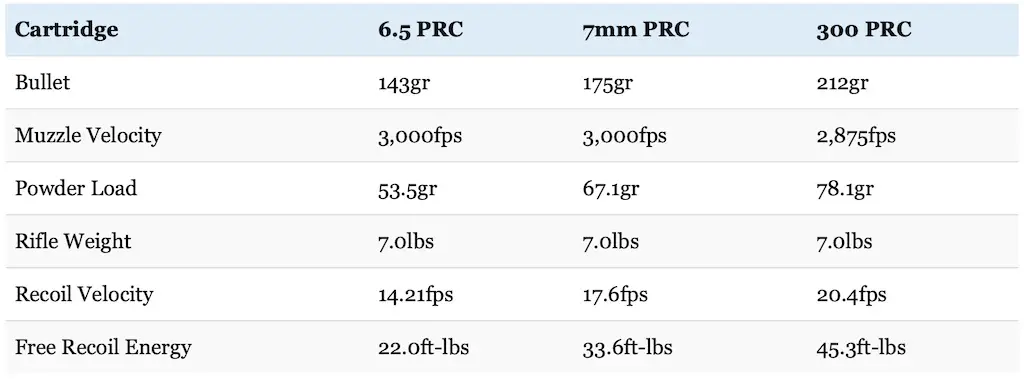
Felt recoil will vary from shooter to shooter and rifle to rifle, but free recoil energy is still a useful way to compare cartridges.
Not surprisingly, the 7mm PRC fits neatly in between the 6.5 PRC and 300 PRC in terms of recoil.
Specifically, the 7mm PRC has about 53% more recoil than the 6.5 PRC and about 25% less recoil than the 300 PRC. The 300 PRC has nearly twice as much recoil as the 6.5 PRC.
Though the 300 PRC is likely delivering recoil that’s toward the upper end of what most hunters can handle, we’re still not talking about ridiculous amounts of recoil here. On the other hand, the 7mm PRC is a very shootable cartridge and the 6.5 PRC has a very mild recoil.
For reference, the 6.5 PRC has just a little more recoil than the light kicking 6.5 Creedmoor. My 7mm PRC has noticeably less recoil than typical .300 Win Mag loads and just a little more recoil than the 7mm Rem Mag.
This is the sort of recoil that many people can handle without a lot of trouble, especially when shooting a rifle that fits them well, that has a good recoil pad, or is equipped with a muzzle brake or suppressor. Even so, it’s still worth mentioning that the 7mm PRC does kick more than the 6.5 PRC and the 300 PRC kicks quite a bit more than either one.
For what it’s worth, recoil on my lightweight 7mm PRC is not bad at all when equipped with my Banish Backcountry suppressor. That whole rig (rifle sling, full magazine, Leupold VX-5 scope, and Banish Backcountry Suppressor) weighs just under 8 pounds.
Don’t underestimate the impact that recoil has on the ability of a person to shoot accurately either. Some people do handle recoil better than others, but all other things being equal, they will absolutely shoot more accurately with a milder recoiling cartridge.
Additionally, there are a couple of other factors that are also worth discussing.
First, the 300 PRC uses larger diameter bullets than the 7mm PRC, which in turn uses larger bullets than the 6.5 PRC.
Specifically, the larger diameter .308″ bullets used by the 300 PRC have about 18% more frontal surface area (also known as cross sectional area) than the 7mm PRC (.0745 vs .0633 square inches) and about 36% more frontal surface area than the 6.5 PRC (.0745 vs .0547 square inches).
At the same time, the .284″ bullets used by the 7mm PRC have about 15% more frontal surface area than the 6.5 PRC (.0745 vs .0547 square inches).
All other things being equal, a bigger bullet will make a bigger hole, cause more tissue damage, and result in more blood loss.
This is a definite advantage in favor of the 300 PRC and a smaller, though still significant advantage in favor of the 7 mm PRC cartridge over the 6.5 PRC.
Those new, heavy, and extremely aerodynamic .284″ caliber bullets used by the 7mm PRC also have a relatively high ballistic coefficient.
The bullets used in this comparison illustrate those differences well with the 7mm PRC using 160gr (.596 BC) and 175gr (.689 BC) bullets outclassing the 130gr (.489 BC) and 143gr (.625 BC) bullets used by the 6.5 PRC as well as the 190gr (.575 BC) and 212gr (.663 BC) bullets used by the 300 PRC.
What about 6.5 PRC vs 7mm PRC vs 300 PRC accuracy?
While external ballistics are extremely important, performance on paper doesn’t mean a darn thing if you can’t hit your target.
Like I mentioned earlier, Hornady implemented some design principles with the 6.5, 7mm, and 300 PRC to help optimize accuracy. Specifically, they built the cartridge with a tight freebore diameter.
Freebore is the smooth portion of a rifle barrel closest to the cartridge. Having a more snug freebore diameter means there’s less room for the bullet to yaw upon firing before engaging the rifling. This can also help enhance accuracy, especially with extremely long bullets.
So, the designers at Hornady built the all the Precision Rifle Cartridges with a tight freebore diameter in a manner similar to what they also did with the 6.5 Creedmoor and what Winchester did with the 6.8 Western.
All of those cartridges each have just .0001″ clearance around bullets when they’re chambered.
Compare that to .0003″ with a .270 Winchester and .0016″ with the .30-06 Springfield.
In any case, the details will vary on the exact rifle, ammunition, and shooter in question. However, the three Precision Rifle Cartridges have some of the best potential for accuracy available today using factory rifles and ammunition.
6.5 PRC vs 7mm PRC vs 300 PRC Availability
Finally, let’s talk about availability of rifles and ammunition.
Hornady raised a few eyebrows when they released the 7mm PRC in the middle of a historic shortage of ammunition and firearms. While some hunters and shooters reacted to the announcement with frustration that Hornady was devoting resources to producing 7mm PRC ammo at the expense of other more popular cartridges that were in short supply, this anger wasn’t as extreme as I saw witnessed with other cartridges introductions (like the 6.8 Western).
Part of this was due to the fact that Hornady released the 7mm PRC over a year after Winchester rolled out the 6.8 Western and the ammunition shortage had eased somewhat.
In any case, 7mm PRC rifles and ammunition are surprisingly easy to find right now. That’s not to say that they’re under every rock and behind every tree, but I did not have any trouble purchasing my new Christensen Arms Ridgeline in FFT (in a left handed version too) or finding ammunition to feed that rifle through normal channels.
Availability likely varies from places to place and I have no doubt that there are areas where availability is uneven. However, several different varieties of 7mm PRC ammo are coming online and don’t seem to be extremely difficult to find (as I type this anyway).
The same is true with rifles from several different manufacturers.
There’s no guarantee what the future may hold, but at least in the near term, the ammo shortage seems to be easing in the United States. With that in mind, ammo and rifles in 6.5 PRC and 300 PRC seem to be more available than those in 7mm PRC right now though.
That’s a good thing though and hunters and shooters should have a pretty good selection of rifles and ammunition in all three cartridges to choose from in the near future. However, I wouldn’t be surprised if the 7mm PRC catches or even surpasses the other two pretty soon either.
So where do we stand overall with these cartridges?
7mm PRC vs 6.5 PRC
The 7mm PRC fires larger, heavier, and usually more aerodynamic bullets at a slightly faster velocity than the 6.5 PRC. The 6.5 PRC has a slight edge in recoil, but the 7mm PRC has a flatter trajectory, less wind drift, and has more kinetic energy at typical hunting ranges and is better for hunting bigger game.
Both cartridges have similar trajectories and similar amounts of wind drift. In fact, both are excellent performers in that category overall when compared to commonly used centerfire hunting cartridges for those who want to squeeze all the performance they can out of a cartridge. That’s especially true for a short action cartridge like the 6.5 PRC.
The 7mm PRC does have more recoil, but it outperforms the 6.5 PRC (which is already excellent in these areas) in terms of trajectory and resistance to wind drift though. Plus, the 7mm PRC uses heavier and larger diameter bullets that have noticeably more kinetic energy at typical hunting ranges. That might not matter too much when hunting deer or pronghorn antelope, but I’d definitely lean towards the 7mm PRC over the 6.5 PRC for game like bear, elk, or moose.
300 PRC vs 7mm PRC
The 300 PRC fires heavier and larger diameter bullets at a slightly slower velocity than the 7mm PRC. The 7mm PRC generally uses more aerodynamic bullets. Therefore, the 300 PRC has an edge with kinetic energy at most ranges, but also has more recoil. The 7mm PRC has an edge with trajectory and wind drift.
The fact that the 300 PRC can use heavier and larger diameter bullets really catapults the 300 PRC onto the next level for work at extended range and/or for hunting bigger game like elk and moose. However, the 7mm PRC is no slouch at all though and holds its own vs the 300 PRC in many areas. Plus, it has a lot less recoil and it’s available in a long-action rifle instead of the longer magnum actions the larger 300 PRC requires.
The fact that the 7mm PRC can outperform the 300 PRC in certain areas and nip at its heels in others while producing much less recoil and still fit in a standard length rifle action says a lot about how well designed and efficient the 7mm PRC is.
That extra power of the 300 PRC is nice to have sometimes, but if we’re being honest, most hunters will not need the extra capability the 300 PRC provides compared to the 7mm PRC. However, that extra power is nice to have for those who want or need that extra performance. For most other people, the 7mm PRC would be a better fit.
Check out the articles below to learn more about how the 7mm PRC compares to other popular rifle cartridges:
6.8 Western vs 7mm PRC: Which New Cartridge Is Right For You?
28 Nosler vs 7mm PRC vs 7mm Rem Mag: Which 7mm Should You Use?
7mm PRC vs 300 Win Mag: Ultimate Guide
7mm PRC Ammo
At this instant, Hornady is the primary company that manufactures factory 7mm PRC ammo. They currently offer three loads for the cartridge: an offering in their Match line loaded with a 180 grain ELD Match bullet, an offering in their Outfitter line with a 160 grain CX bullet, and an offering in their Precision Hunter line with a 175-grain ELD-X bullet.
While that Match offering is specifically intended for competition shooters who want an incredibly accurate and flat shooting load for banging steel or punching paper at extended range (not for hunting), those Match bullets are not designed for optimum performance on game.
Instead, look at the Outfitter and Precision Hunter 7 mm PRC loads, both of which are excellent for hunting all manner of game in North America and elsewhere in the world.
Federal recently started making 7mm PRC ammo as well in their Premium Line using the 175gr ELD-X. The ballistics of that load are identical to the Hornady Precision line.
While the initial lots of Hornady Precision Hunter 7mm PRC ammo I tested back in 2023 performed great, certain lots produced in 2024 have attracted a lot of attention in the hunting community for falling well short of their advertised velocity of 3,000fps.
I did an in-depth investigation into this 7mm PRC ammo controversy in the spring of 2024 and here’s what I discovered:
Moving on, Federal also launched the cartridge in their Terminal Ascent line firing 155gr Terminal Ascent and the 170gr Terminal Ascent bullets. Remington also recently picked up the cartridge and now offers 7mm PRC factory ammo loaded with a 175gr Speer Impact bullet in their Premier Long Range line.
Federal and Remington also announced new 7mm PRC ammunition offerings at the 2024 SHOT show in their Tipped Fusion, Core Lokt Tipped, and CuT lines.
Nosler also rolled out a 7mm PRC factory load with a 175gr AccuBond Long Range in early 2024 as well.
Weatherby also picked up the cartridge. Current Weatherby 7mm PRC ammo offerings include loads with 150gr Scirocco II, 175gr Berger Elite Hunter, and 177gr Hammer Custom bullets.
Furthermore, 7 mm PRC ammo prospects are looking great in the near future and there are also rumblings that even more companies (like Barnes) will pick up the cartridge as well later in 2024 and on into the future.
Fortunately, the ammunition selection for the cartridge is decent online as I type this.
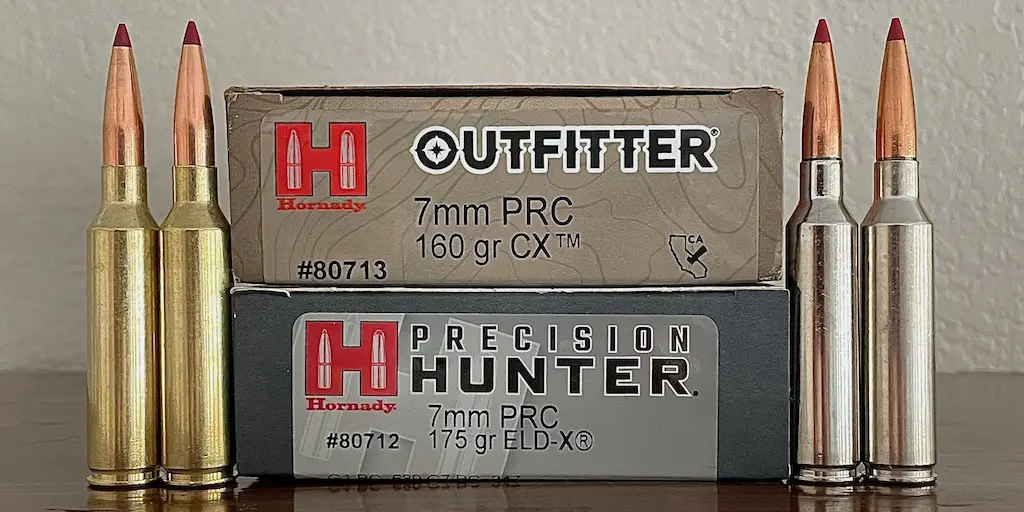
Best 7mm PRC Ammo For Hunting
Even though Hornady is the primary company offering ammunition for the 7mm PRC at this instant, they’ve done a very good job of designing and producing a couple of different loads that are very effective afield. Additionally, Hornady has also done good work in getting their ammunition for the cartridge to market in the ongoing ammunition shortage.
If you’d like to learn more about some of the various hunting ammunition choices for the 7mm PRC read this article:
Best 7mm PRC Ammo For Hunting Elk, Deer, & Bear
7mm PRC Rifles
Among other rifle manufacturers, Christensen Arms, Fierce Firearms, GA Precision, Gunwerks, Hill Country Rifles, Mossberg, Proof Research, Remington, Ruger, Savage Arms, Seekins Precision, and Springfield Armory all produce 7mm PRC rifles. That list of 7 mm PRC rifles will likely continue to grow as well.
In particular, the the Christensen Arms Ridgeline is a fantastic factory rifle for those who want outstanding long range capability in a hunting rifle chambered in 7mm PRC.
I personally absolutely love my Ridgeline FFT. It has a 22″ barrel, which is a good balance of being long enough to deliver good velocity without being too big or bulky. Plus, it’s light and very easy to carry. Mine tips the scales at just over 7 pounds fully loaded and wearing a Leupold VX-5HD scope.
That’s what I took to Africa and it performed magnificently!
BUY A CHRISTENSEN ARMS RIDGELINE FFT HERE
ALSO BUY A CHRISTENSEN ARMS RIDGELINE FFT HERE
If you’d like to learn more about some of the various hunting rifle choices for the 7mm Precision Rifle Cartridge, read this article:
Final Thoughts On The 7mm PRC
Is the 7mm PRC just the latest flash in the pan that will eventually fade into obscurity like so many other cartridges rolled out in recent decades after the initial marketing hype faded?
It’s impossible to know for sure at this point, but I don’t think that will happen.
Just like you should never go in against a Sicilian when death is on the line, you should never bet against Hornady’s design and marketing teams. The 7mm PRC is a great example of their expertise in designing high performing, yet efficient cartridges, building outstanding factory ammunition, and promoting those products like no other company in the world today.
I think they hit it out of the park with the 7mm Precision Rifle Cartridge and, if the literally unprecedented enthusiasm surrounding the cartridge right now is any indication, most hunters and shooters agree with me.
Marketing and hype aside, the new cartridge does provide significant benefit to hunters, especially for those hunting out west for bigger game like elk where distances can start to get pretty long. I don’t know of another cartridge that offers the superb balance of a flat trajectory, great resistance to wind deflection, surprisingly moderate recoil, and excellent retained energy at extended range the 7mm PRC provides.
Plus, the accuracy potential for the cartridge is outstanding, even for those using off the shelf rifles and factory ammunition.
The 6.5 Creedmoor gets a lot of (largely, but not completely underserved in my opinion) hate for being underpowered. However, even those who dislike the cartridge usually still give it high marks for accuracy.
Well, the 7mm PRC seems to have accuracy potential on par with the 6.5 Creedmoor while at the same time providing a massive step up in power.
I’m not encouraging anyone to go out and use the 7mm PRC for any extreme long range hunting scenario. That said, I think it’s a better choice for those who want to reach out a bit than other highly regarded favorites for that sort of work like the 7mm Rem Mag.
I wouldn’t necessarily recommend the 7mm PRC to the average eastern whitetail hunter who never plans on hunting anywhere else. That said, I think the 7mm PRC would be perfect someone looking for ideal all-around rifle cartridge for use on wide range of game like mule deer, black bear, pronghorn, elk, moose, and African plains game.
There’s no guarantee what the future may hold, but I think the future is looking bright for the 7mm PRC.
Enjoy this article about the 7mm PRC? Please share it with your friends on Facebook and Twitter.
Hornady provided information for the history of the 7mm PRC. The data used to compare the trajectory and recoil of the cartridges was obtained from Hornady’s web site (here, here, here, here, here, here, and here). Maximum pressure and data to compare cartridge sizes for the 6.5 PRC, 7mm PRC and 300 PRC were obtained from SAAMI (here, here, and here). Case capacity information for the 6.5 PRC, 7mm PRC, and 300 PRC were obtained from Backfire.TV. Frontal surface area information was obtained from Chuck Hawks. I used Shooters Calculator to compare trajectories, wind drift, and recoil for the cartridges.
Make sure you subscribe to The Big Game Hunting Podcast and follow The Big Game Hunting Blog on Facebook, Instagram, Twitter, and YouTube.
NEXT: BEST 6.5 CREEDMOOR AMMO FOR HUNTING ELK, DEER, AND OTHER BIG GAME
NEXT: 11 BEST HUNTING EAR PROTECTION OPTIONS FOR HUNTERS IN 2021
NEXT: 101 BEST GIFTS FOR HUNTERS
John McAdams is a proficient blogger, experienced shooter, and long time hunter who has pursued big game in 8 different countries on 3 separate continents. John graduated from the United States Military Academy at West Point and is a veteran of combat tours with the US Army in Iraq & Afghanistan. In addition to founding and writing for The Big Game Hunting Blog, John has written for outdoor publications like Bear Hunting Magazine, The Texas State Rifle Association newsletter, Texas Wildlife Magazine, & Wide Open Spaces. Learn more about John here, read some of John’s most popular articles, and be sure to subscribe to his show: the Big Game Hunting Podcast.

